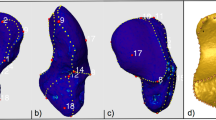Abstract
Purpose
Scaphoid fractures are commonly fixed with headless cannulated screws positioned centrally in the scaphoid. Judgement of central placement of the screw may be difficult. We generated a central zone using computer analysis of 3D reconstructions of computed tomography (CT) images. As long as the screw axis is completely contained within this central zone, the screw would be considered as centrally placed.
Methods
Thirty cases of 3D CT reconstructions of normal scaphoids in a computerised operation planning and simulation system (Vxwork software) were obtained. The central zone was established after some distance shrinkage of the original scaphoid surface reconstruction model using the function “erode” in the software. The shape of the central zone was evaluated, and the width of the central zone in the proximal pole, waist portion and distal pole was measured. We also established the long axis of the scaphoid to see whether it stays in the central zone.
Results
All central zones could be divided into distal, waist and proximal portions according to the corresponding irregular shape of the scaphoid. As the geometry of the central zone was so irregular and its width very narrow, it was possible to completely contain the screw axis either in the proximal portion alone, waist alone or distal central zone alone.
Conclusions
Establishing the central zone of scaphoid 3D CT images provided a baseline for discussion of central placement of a scaphoid screw. The geometry of the scaphoid central zone determined that the screw could hardly be inserted through entire scaphoid central area during surgery.





Similar content being viewed by others
References
Compson JP (1998) The anatomy of acute scaphoid fractures: a three-dimensional analysis of patterns. J Bone Joint Surg Br 80(2):218–224
Compson JP, Waterman JK, Heatley FW (1994) The radiological anatomy of the scaphoid. Part 1: osteology. J Hand Surg Br 19(1):183–187
Ezquerro F, Jimenez S, Perez A, Prado M, de Diego G, Simon A (2007) The influence of wire positioning upon the initial stability of scaphoid fractures fixed using Kirschner wires. A finite element study. Med Eng Phys 29:652–660
Geurts G, van Riet R, Meermans G, Verstreken F (2011) Incidence of scaphotrapezial arthritis following volar percutaneous fixation of nondisplaced scaphoid waist fractures using a transtrapezial approach. J Hand Surg 36A:1753–1758
Guo Y, Tian GL (2011) The length and position of the long axis of the scaphoid measured by analysis of three-dimensional reconstructions of computed tomography images. J Hand Surg 36B:98–101
Kehoe NJ, Hackney RG, Barton NJ (2003) Incidence of osteoarthritis in the scapho-trapezial joint after Herbert screw fixation of the scaphoid. J Hand Surg 28B:496–499
Leventhal EL, Wolfe SW, Walsh EF, Crisco JJ (2009) A computational approach to the “optimal” screw axis location and orientation in the scaphoid bone. J Hand Surg 34A:677–684
Levitz S, Ring D (2005) Retrograde (volar) scaphoid screw insertion—a quantitative computed tomographic analysis. J Hand Surg Am 30(3):543–548
Luria S, Hoch S, Liebergall M, Mosheiff R, Peleg E (2010) Optimal fixation of acute scaphoid fractures: finite element analysis. J Hand Surg 35A:1246–1250
McCallister WV, Knight J, Kaliappan R et al (2003) Central placement of the screw in simulated fractures of the scaphoid waist: a biomechanical study. J Bone Joint Surg Am 85(1):72–77
Merrell G, Slade J (2008) Technique for percutaneous fixation of displaced and nondisplaced acute scaphoid fractures and select nonunions. J Hand Surg 33A:966–973
Nakamura R, Imaeda T, Horii E et al (1991) Analysis of scaphoid fracture displacement by three-dimensional computed tomography. J Hand Surg Am 16(3):485–492
Naranje S, Kotwal PP, Shamshery P, Gupta V, Nag HL (2010) Percutaneous fixation of selected scaphoid fractures by dorsal approach. Int Orthop 34(7):997–1003
Nicholl JE, Buckland-Wright JC (2000) Degenerative changes at the scaphotrapezial joint following Herbert screw insertion: a radio- graphic study comparing patients with scaphoid fracture and primary hand arthritis. J Hand Surg 25B:422–426
Noland SS, Saber S, Endress R, Hentz VR (2012) The scaphotrapezial joint after partial trapeziectomy for trapeziometacarpal joint arthritis: long-term follow-up. J Hand Surg 37A:1125–1129
Slade Iii JF, Grauer JN, Mahoney JD (2001) Arthroscopic reduction and percutaneous fixation of scaphoid fractures with a novel dorsal technique. Orthop Clin North Am 32:247–261
Soubeyrand M, Biau D, Mansour C, Mahjoub S, Molina V, Gagey O (2009) Comparison of percutaneous dorsal versus volar fixation of scaphoid waist fractures using a computer model in cadavers. J Hand Surg 34A:1838–1844
Trumble TE, Gilbert M, Murray LW, Smith J, Rafijah G, McCallister WV (2000) Displaced scaphoid fractures treated with open reduction and internal fixation with a cannulated screw. J Bone Joint Surg Am 82(5):633–641
Viegas SF, Wagner K, Patterson R, Peterson P (1990) Medial (hamate) facet of the lunate. J Hand Surg Am 15(5):564–571
Vinnars B, Pietreanu M, Bodestedt A, Ekenstam F, Gerdin B (2008) Nonoperative compared with operative treatment of acute scaphoid fractures. A randomized clinical trial. J Bone Joint Surg Am 90(6):1176–1185
Author information
Authors and Affiliations
Corresponding author
Rights and permissions
About this article
Cite this article
Guo, Y., Tian, G.L., Chen, S. et al. Establishing a central zone in scaphoid surgery: a computational approach. International Orthopaedics (SICOT) 38, 95–99 (2014). https://doi.org/10.1007/s00264-013-2089-9
Received:
Accepted:
Published:
Issue Date:
DOI: https://doi.org/10.1007/s00264-013-2089-9




